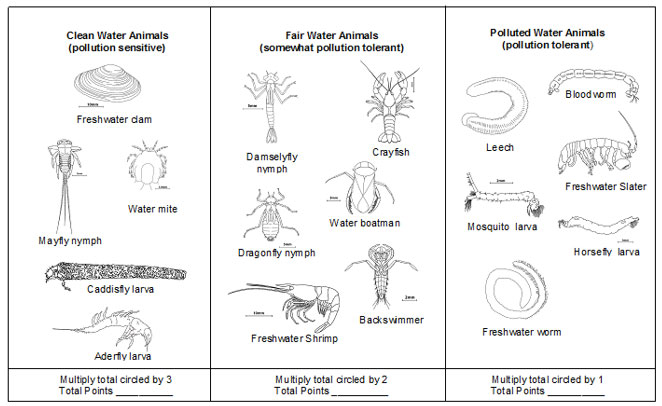
The diversity of animals living in a body of water, such as a stream or pond, is one of the best indicators of water quality. Scientists use samples of invertebrates, animals without backbones, that live in the bottom of a water source to locate areas with fresh water. These invertebrates can be seen without the use of a microscope and are, therefore, called macroinvertebrates.
Scientists monitor macroinvertebrates because they are easy to collect and show a large diversity in body shapes and adaptations. Many aquatic invertebrates require clear, cool water, adequate oxygen, stable water flow, and a steady source of food in order to complete their life cycles. Other invertebrates are not as sensitive and can live in more unstable and polluted waters. The invertebrates, in turn, provide food for other species of animals that live in watershed areas, such as fish, turtles, and birds.
Scientists can use a chart, like the one found below, to determine a numerical score for the quality of a body of water. The higher the score, the cleaner the water is thought to be. The numeric system is as follows:

Human activities that alter the watershed have immediate and long-term effects on the animals that live in that area. Humans can have both positive and negative effects on a watershed.
![]() Click on the next step button to begin the animation.
Click on the next step button to begin the animation.
Answer the following questions.
Interactive popup. Assistance may be required.
It is the type of organisms present that determines the water quality.
Interactive popup. Assistance may be required.
Macroinvertebrates are used to analyze water quality because they are easy to collect and show a large diversity in body shapes and adaptations.
Interactive popup. Assistance may be required.
Jackson Lake had the best water quality.
Interactive popup. Assistance may be required.
Houston Creek had the poorest water quality. The low quality could be caused by the businesses located near the creek, especially the dry cleaner. These businesses could drain chemicals into the creek. The heavy traveled bridge could also cause chemicals from automobiles to drain into the creek. Practices that could increase the quality of the water are careful monitoring of the businesses near the area, as well as the traffic on the bridge. To improve water quality, neighborhood residents could hold a cleanup of the creek area and begin a water quality-testing program.